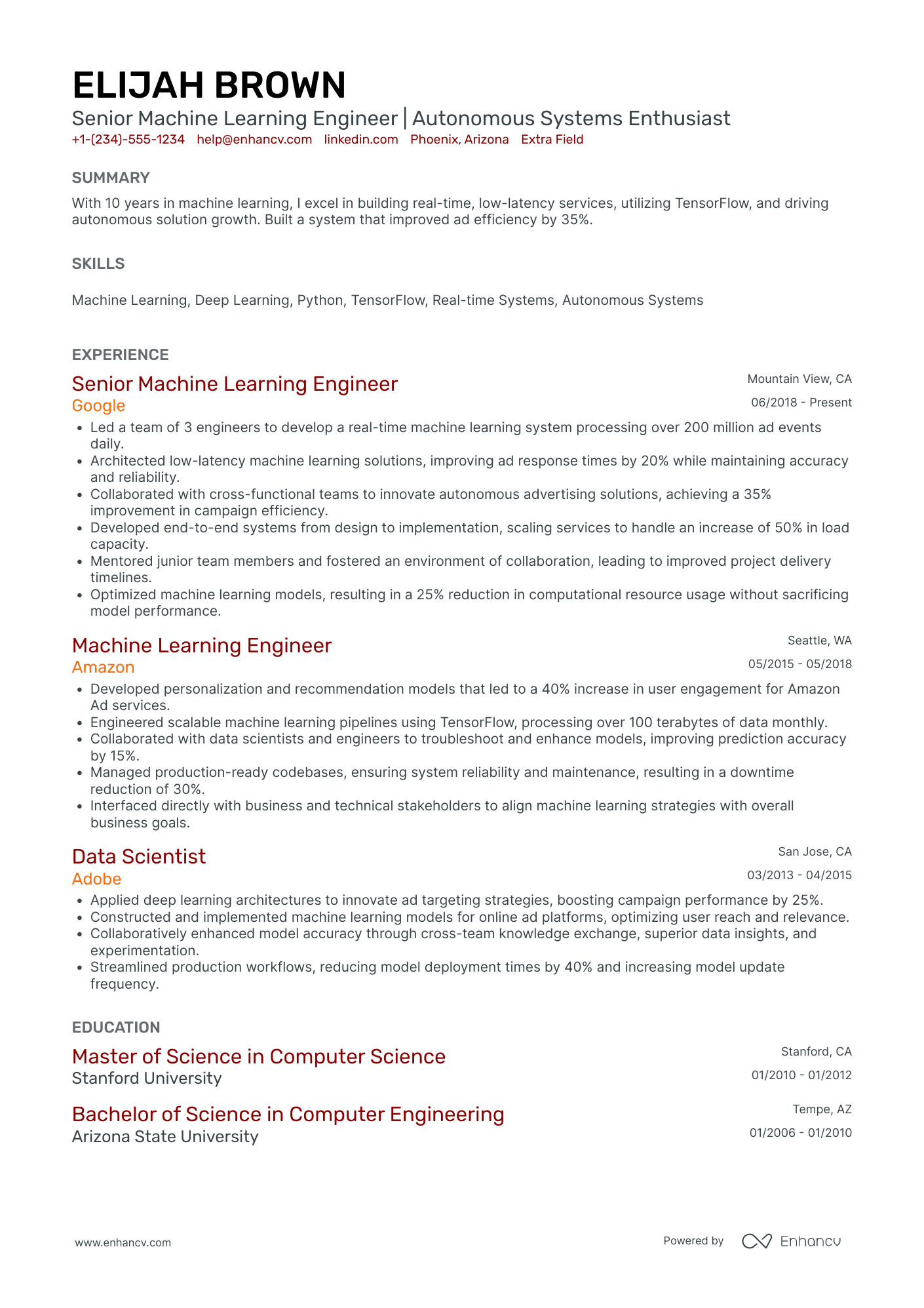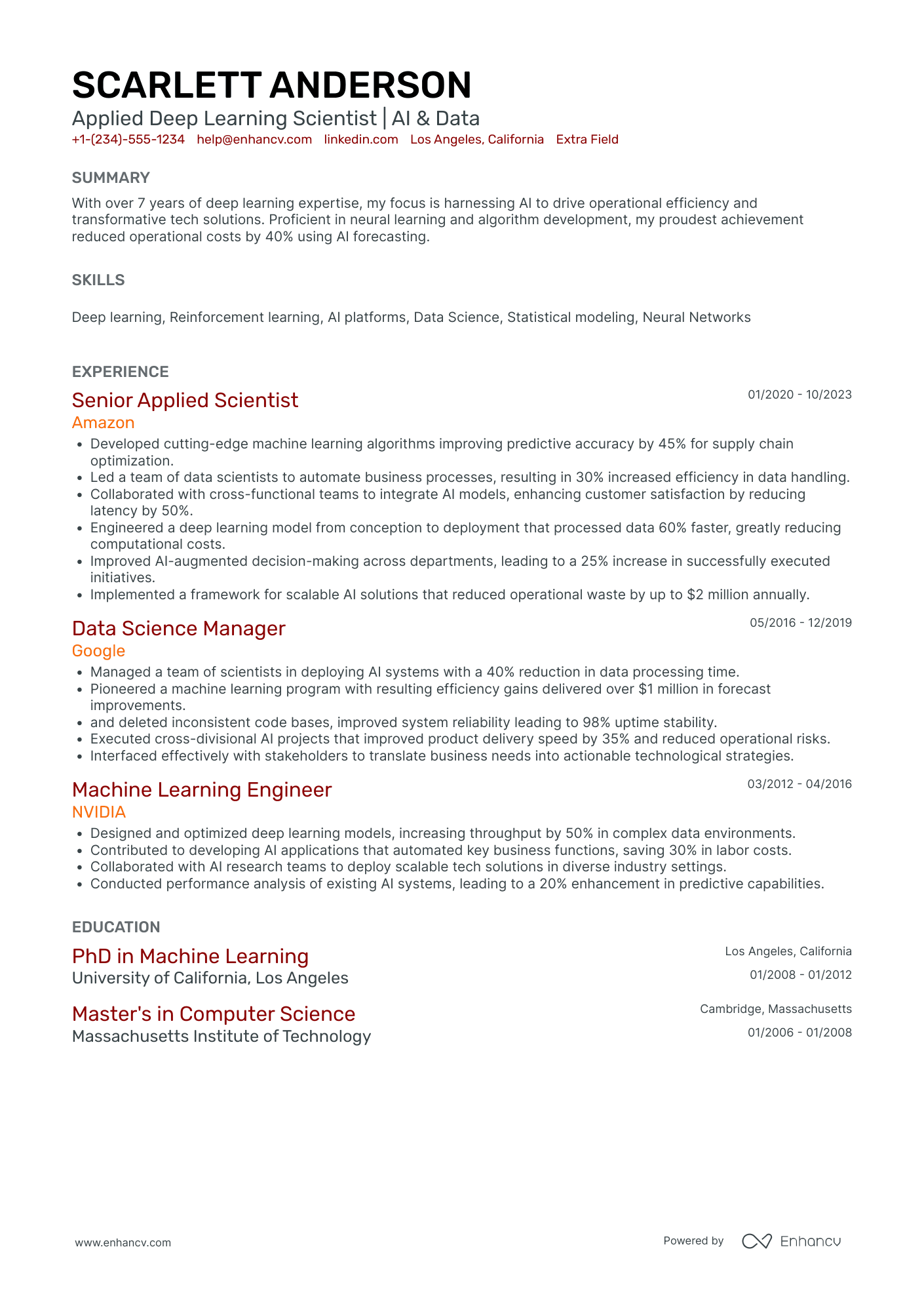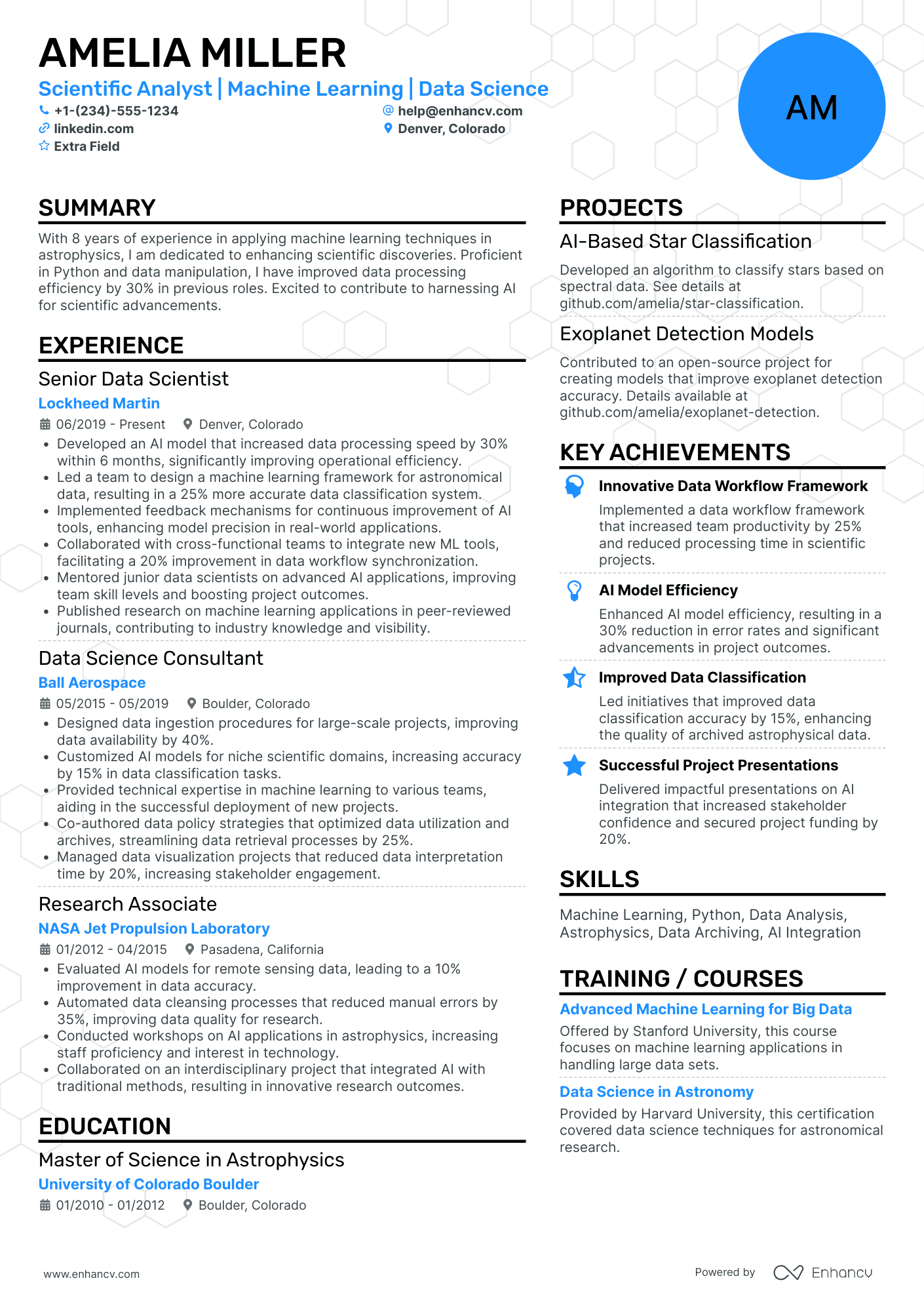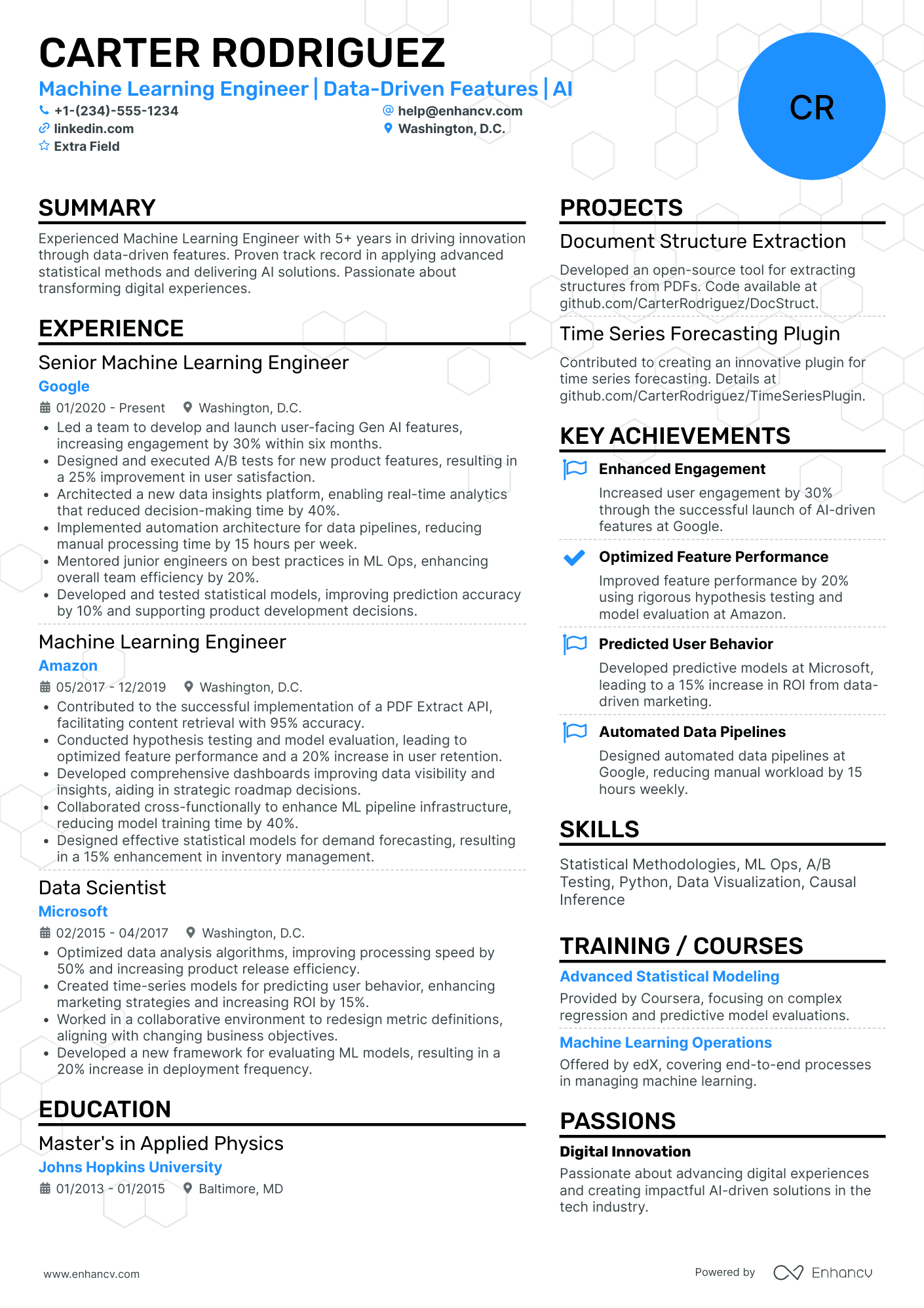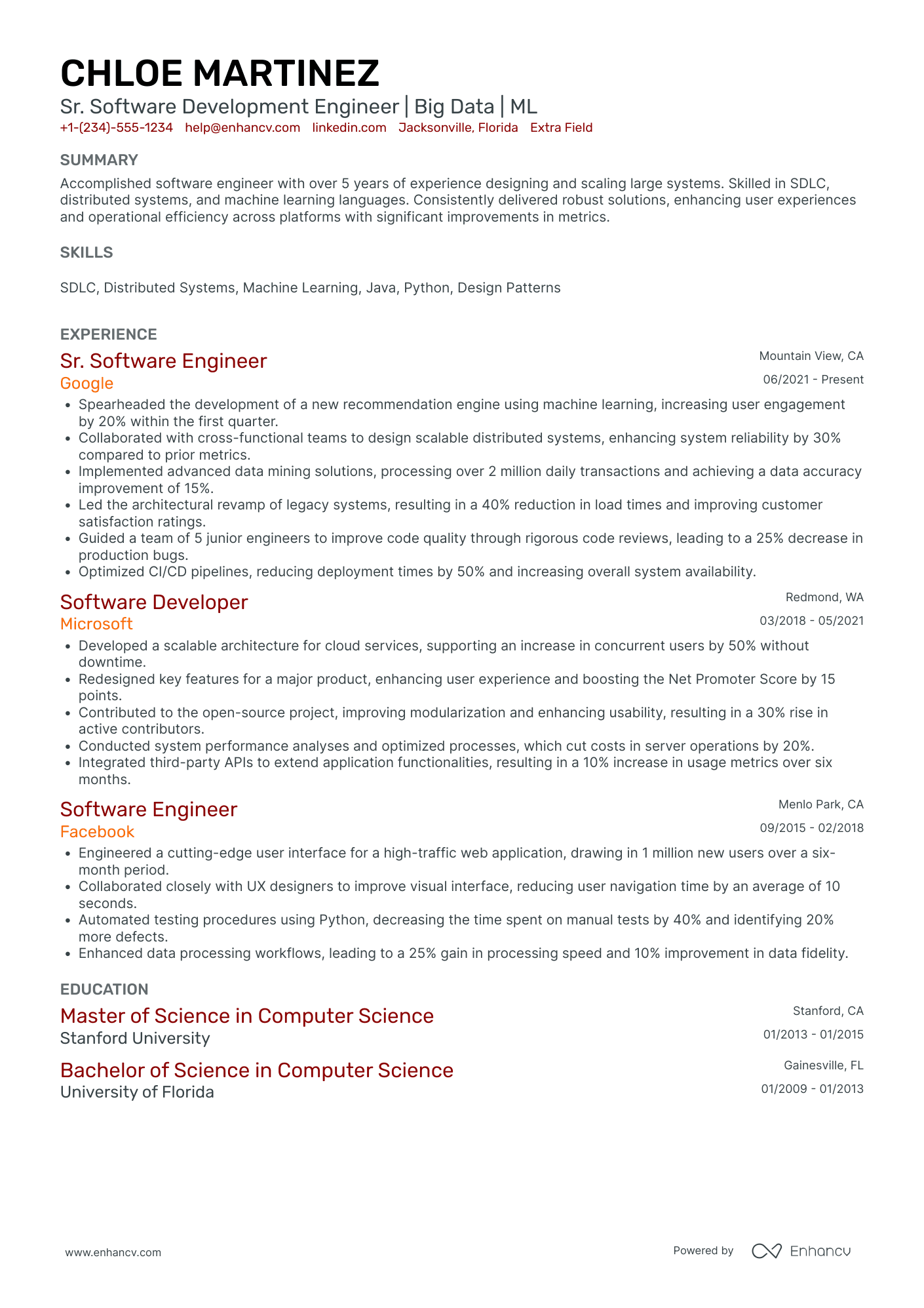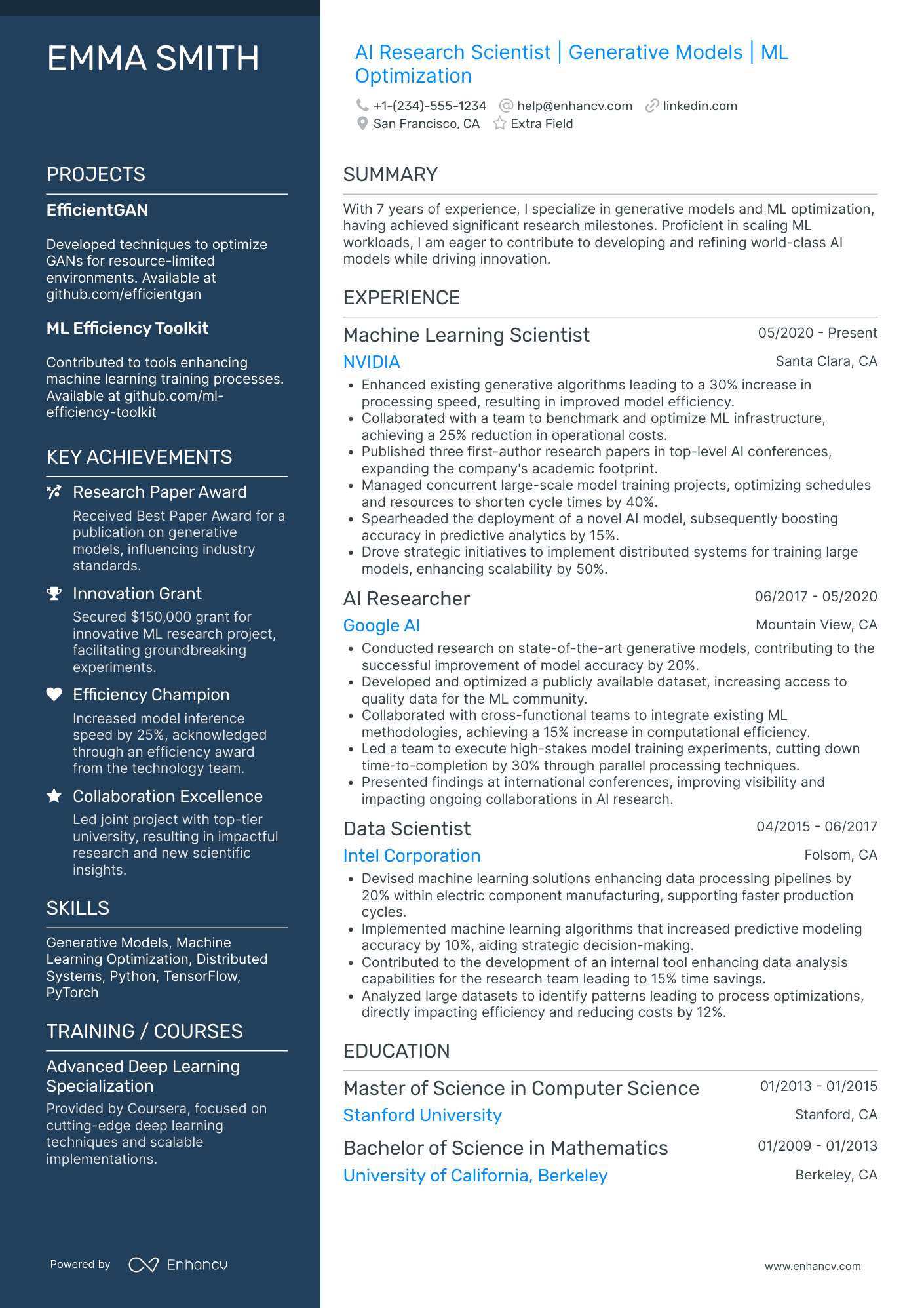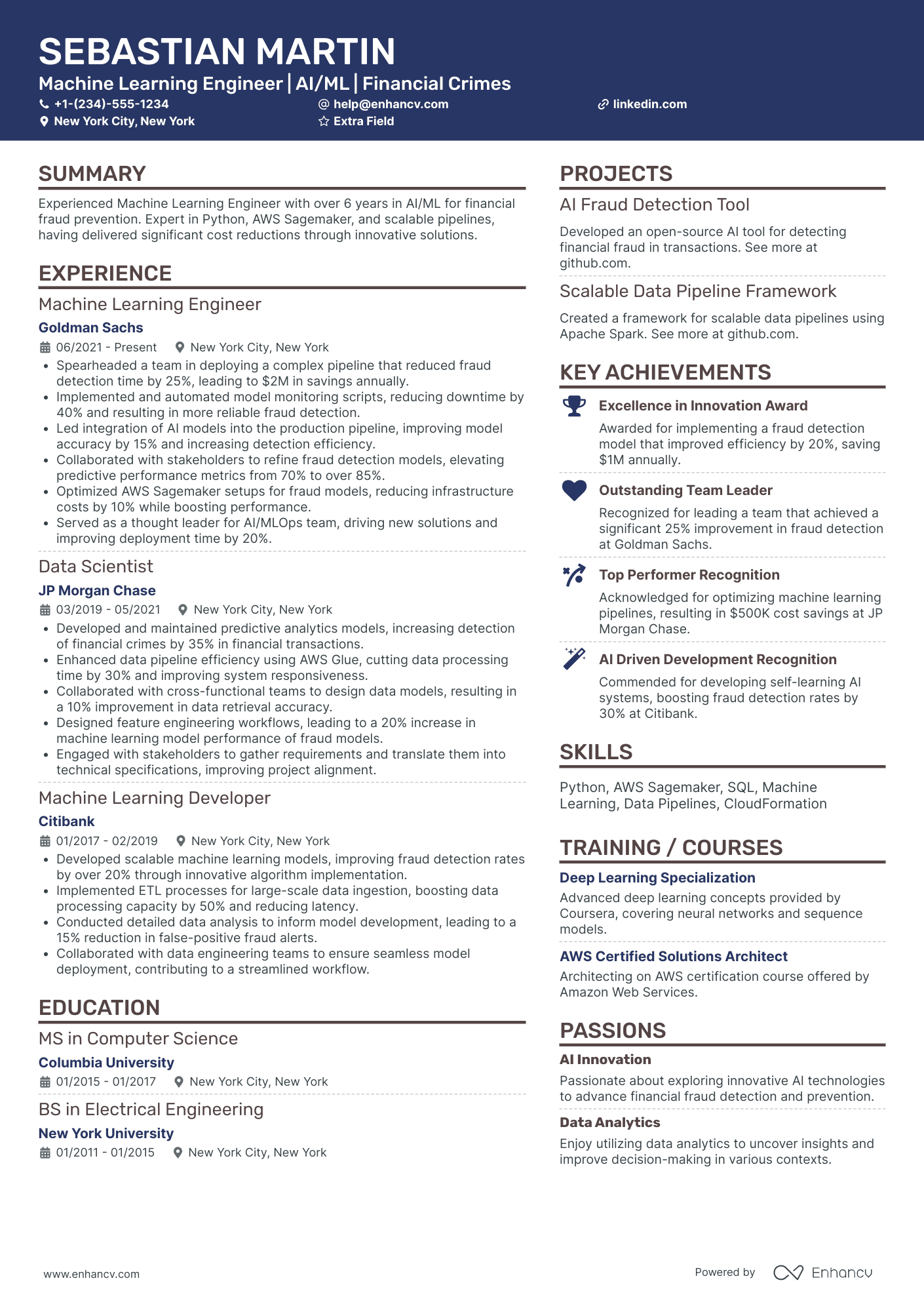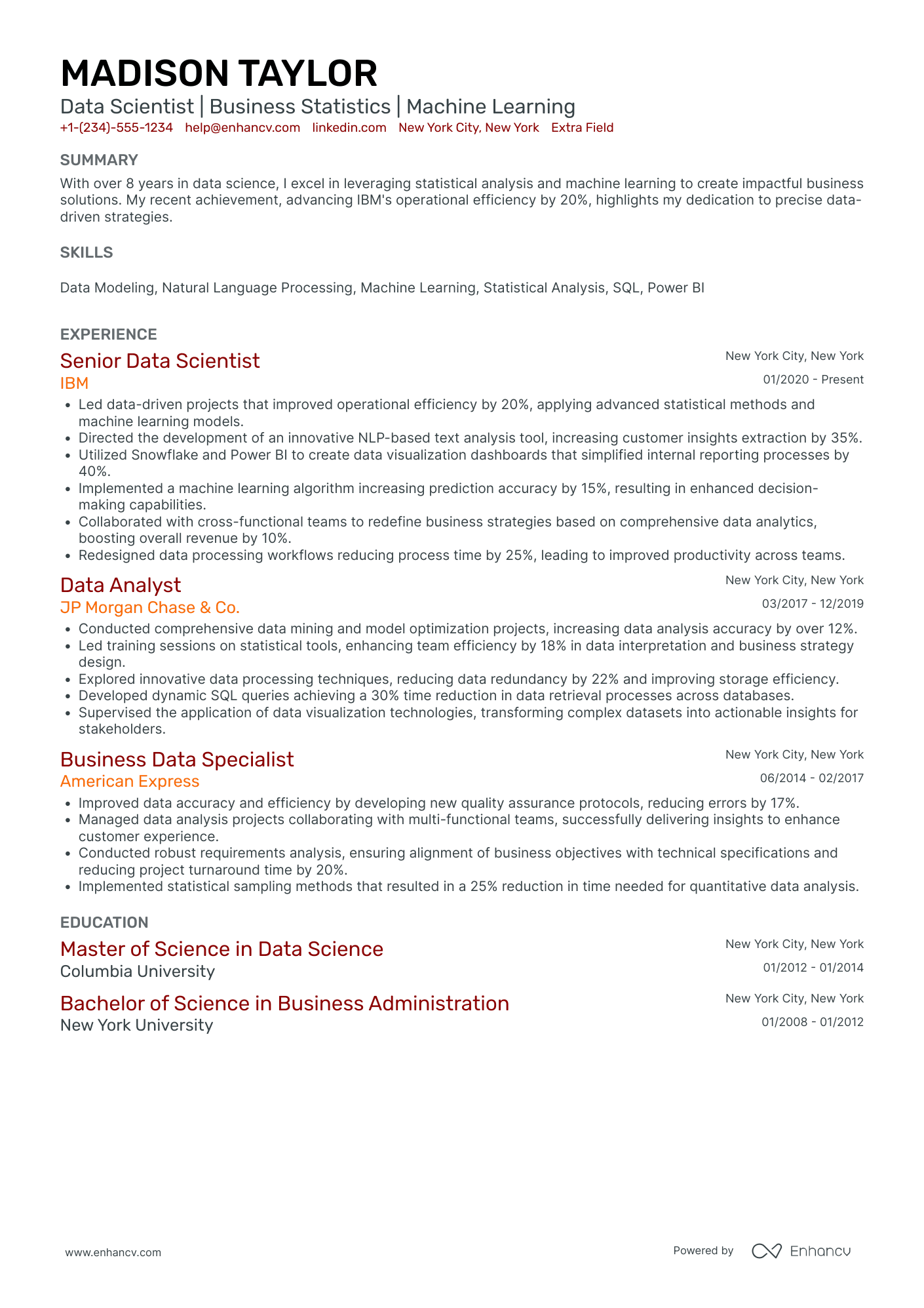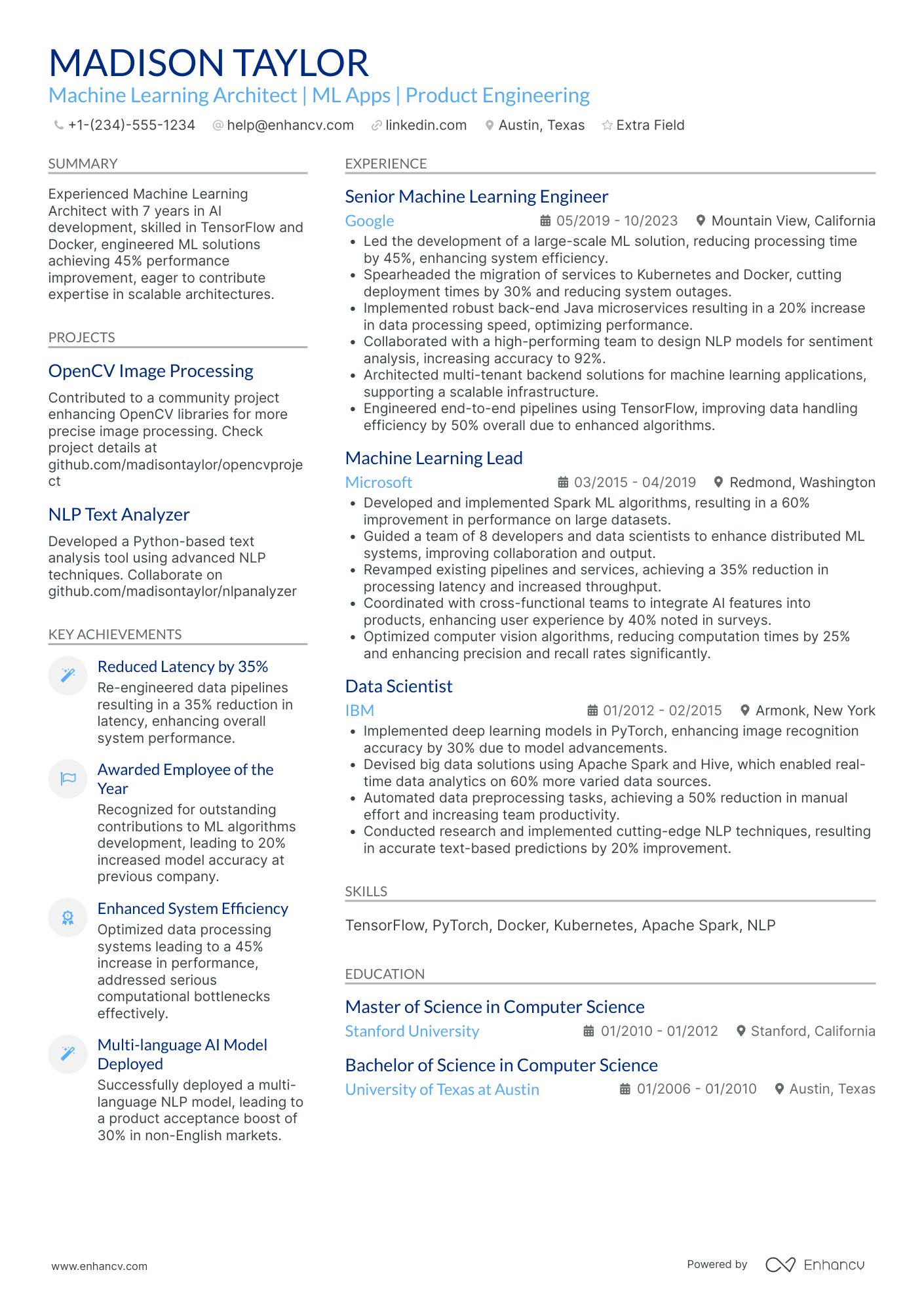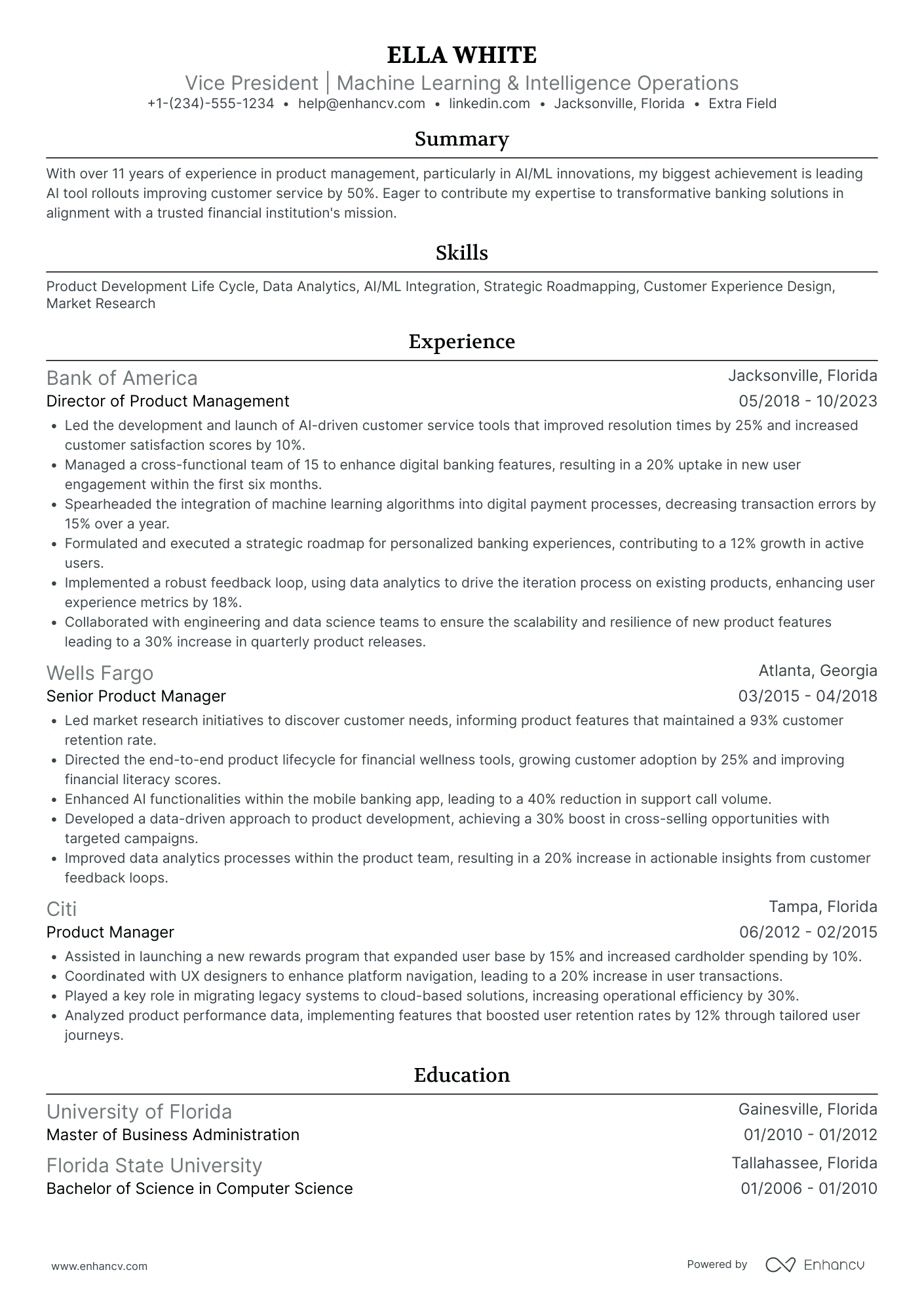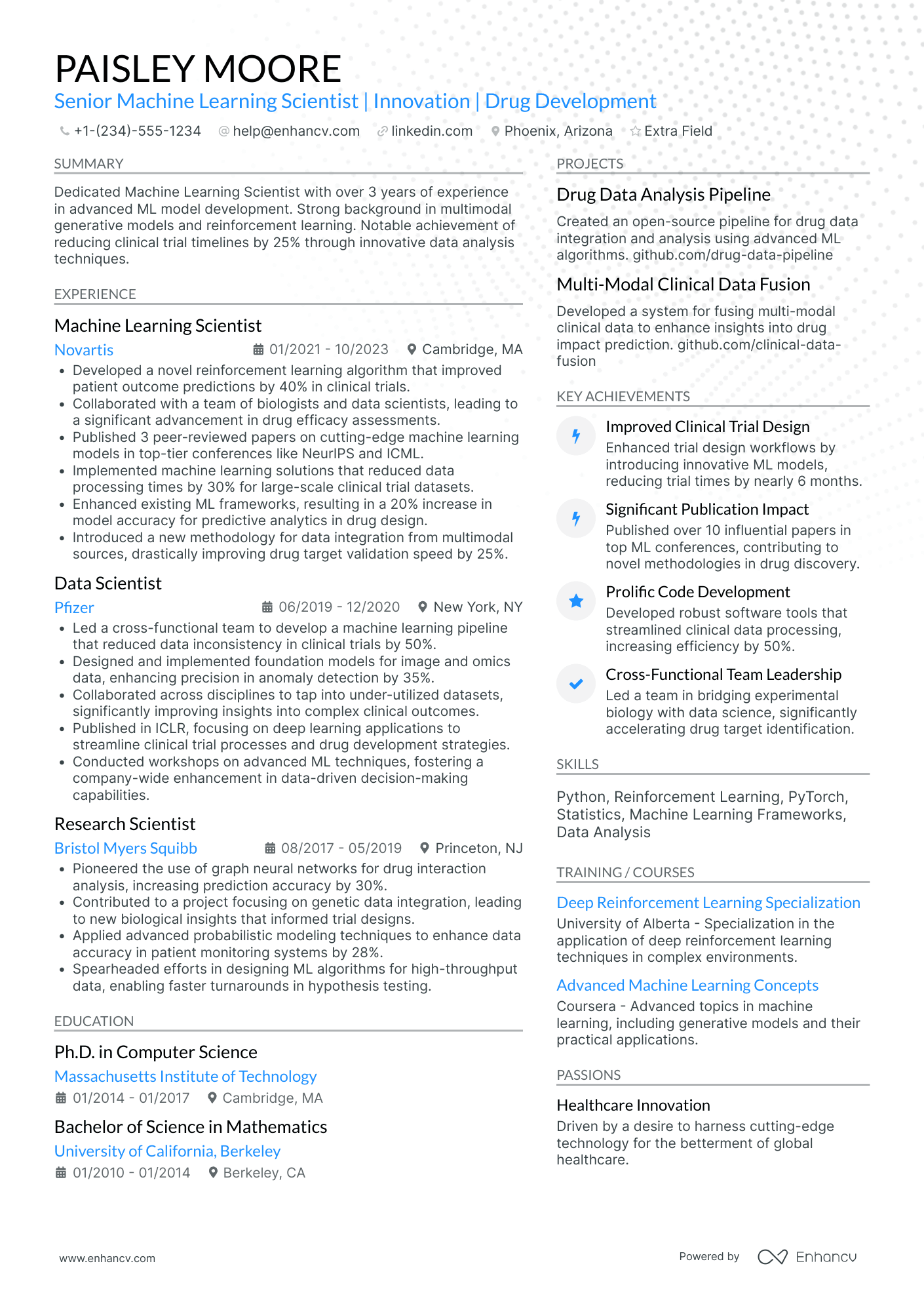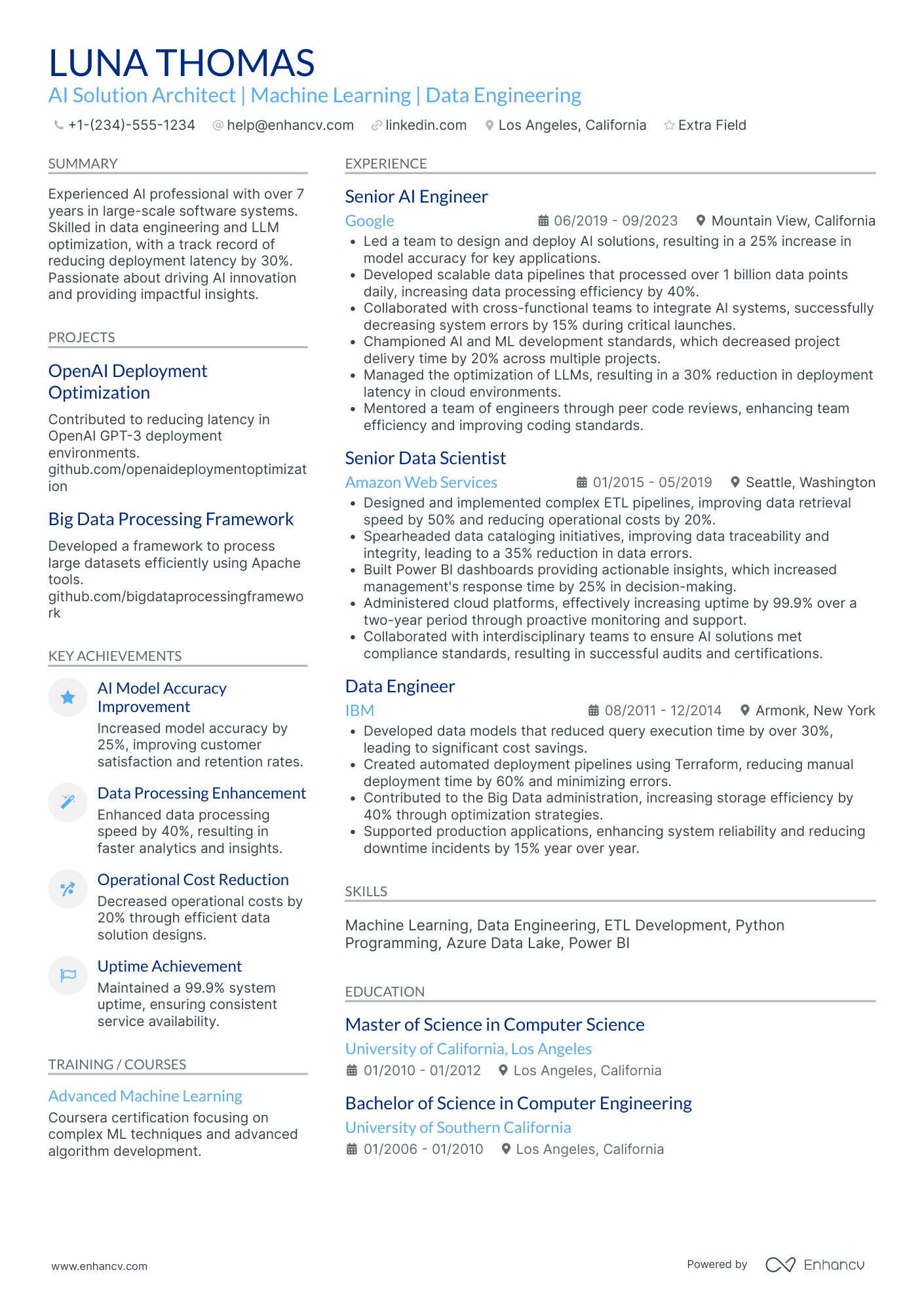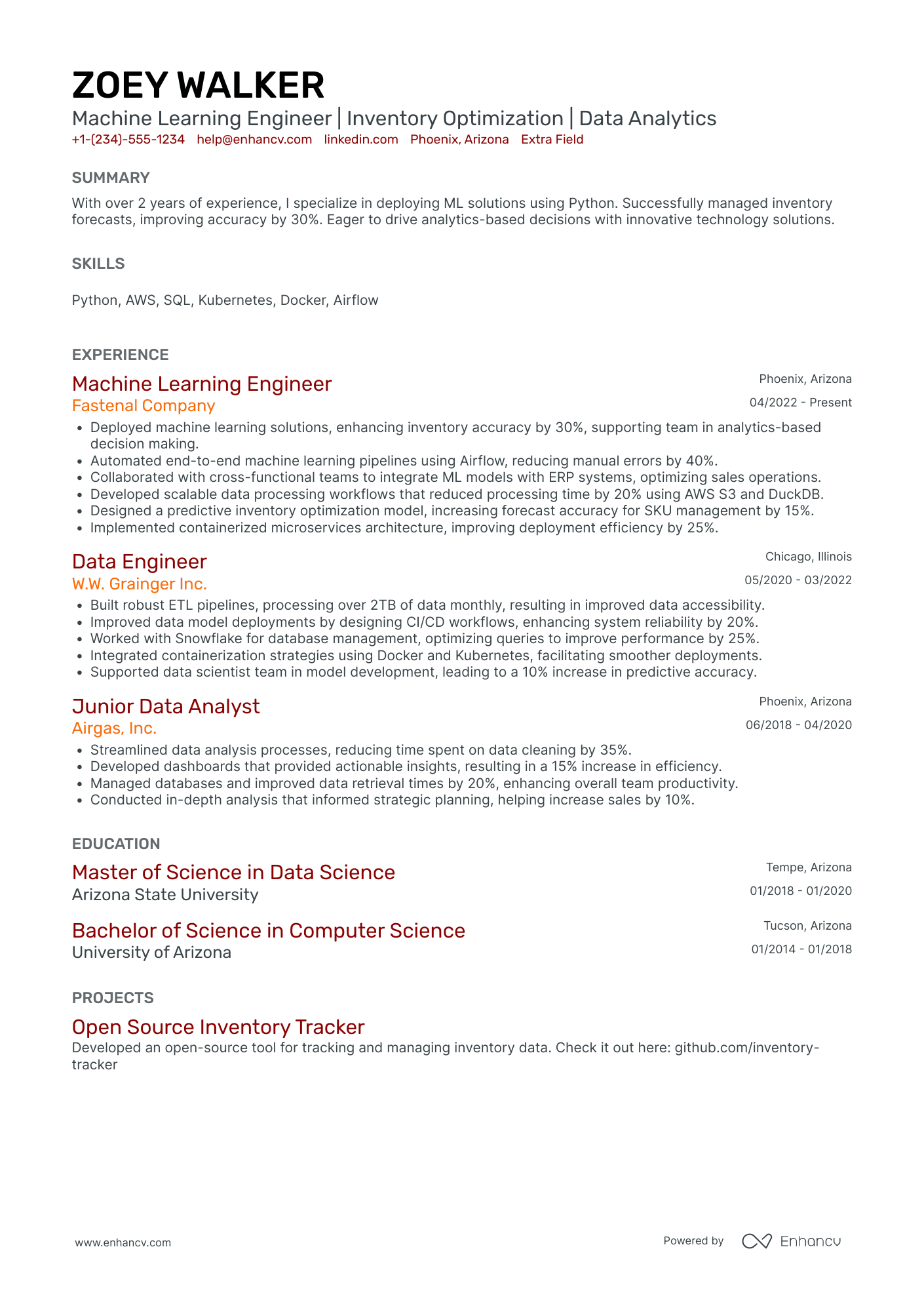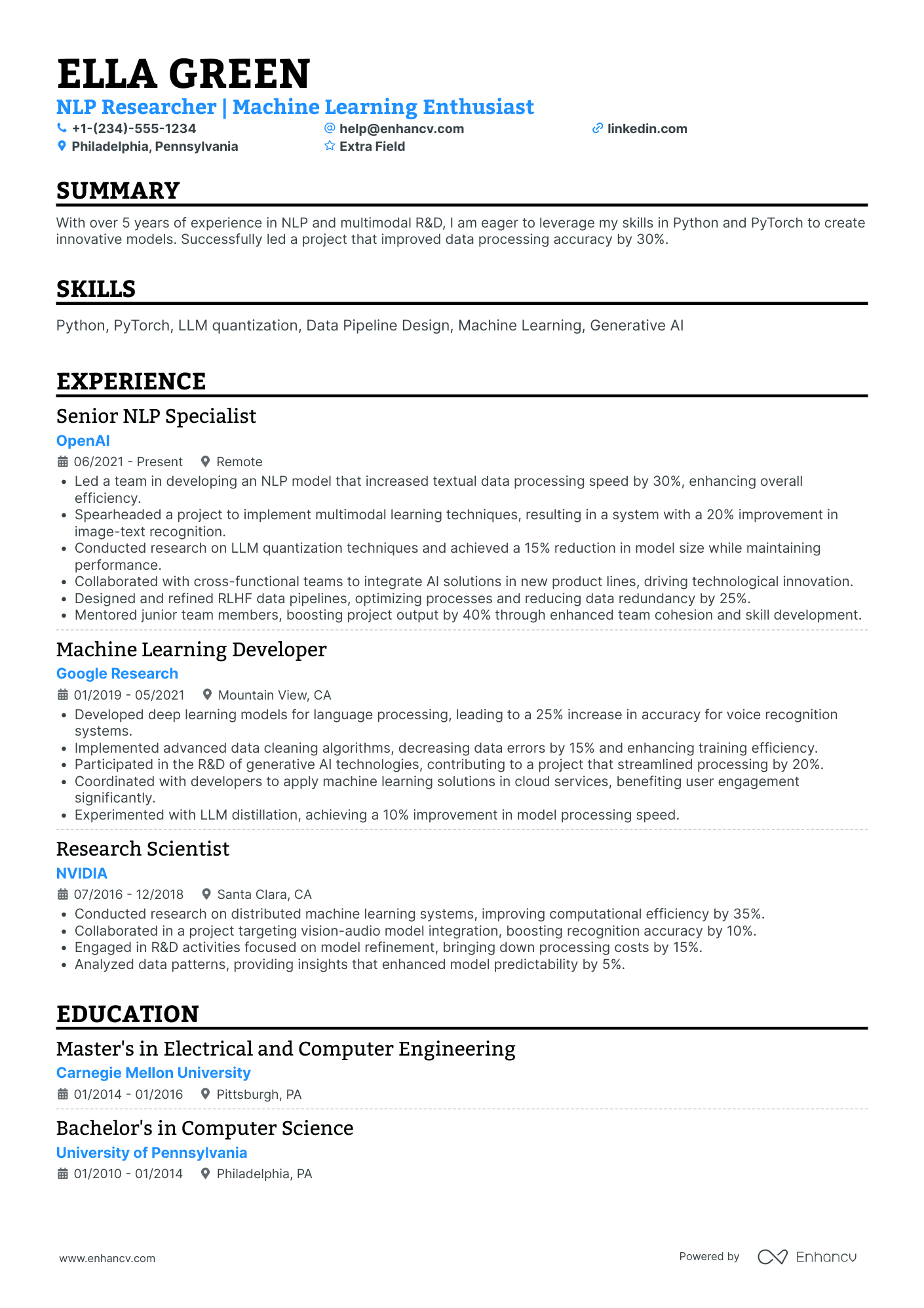Remember how cloud technology took off a few years ago? Early adopters are now reaping the benefits. Experts believe machine learning (ML) follows the same path, becoming essential for product development and opening up exciting career opportunities.
Machine learning market insights
According to the Fortune Business Insight, the global machine-learning market is forecasted to grow to $209.91 billion by 2029 with a 38.8% compound annual growth rate (CAGR).
However, the competition is tough, with many vying for positions in this growing field. Recruiters often seek candidates with advanced degrees, extensive experience, and impressive credentials. If you're a machine learning engineer, whether you're just starting out or looking to advance, our ML resume guide can help you make the most of your experience, ensuring your skills and achievements stand out to recruiters.
Here’s the gist:
Key takeaways
- Focus on specific accomplishments in your projects and work to show real-world impact.
- Incorporate relevant keywords from the job description to make your resume ATS-friendly.
- Use numbers to detail your contributions and results.
- List relevant certifications to prove your expertise and commitment to the field.
- Tailor your resume for each application to emphasize the most relevant skills and experiences.
- If space allows, consider including extra sections like publications, professional affiliations, or language skills to round out your profile.
Now that you understand the basics, explore a sample ML resume, illustrating how to structure your information for optimal impact.
Machine learning resume sample
This machine learning resume template will save you time and make a great first impression.
Mark Thompson
mark.thompson@email.com @ LinkedIn Phoenix, AZ
Summary
Dynamic machine learning Engineer with over 2 years of experience in developing and deploying machine learning models for fraud detection and platform safety. Skilled in data analysis, anomaly detection, and implementing scalable ML workflows. Proven ability to collaborate with cross-functional teams and mentor peers. Passionate about improving online trust and safety, with a focus on responsible AI and Safety-by-Design.
Skills
- Machine learning: Supervised and Unsupervised Learning, Anomaly Detection
- Programming: Python, SQL, GraphQL, Flink
- Tools: Azure machine learning, Kusto, Data Visualization Tools
- Other: Data Storytelling, Technical Documentation, Cross-Functional Collaboration
Experience
machine learning Engineer
Tech Solutions Inc., Phoenix, AZ
June 2022 — Present
- Developed and implemented machine learning models that reduced fraudulent activities by 30%.
- Conducted thorough data analysis, identifying patterns and trends that led to a 20% improvement in threat detection accuracy.
- Utilized Azure machine learning services, resulting in a 40% increase in workflow efficiency.
- Collaborated with cross-functional teams, integrating ML solutions that improved platform safety metrics by 25%.
- Documented systems and processes, enhancing team knowledge and technical growth, contributing to a 15% reduction in onboarding time for new engineers.
Data Scientist Intern
DataSecure, Phoenix, AZ
January 2021 — May 2022
- Assisted in developing anomaly detection algorithms, increasing fraud detection rates by 15%.
- Conducted data visualization and storytelling, leading to a 10% improvement in stakeholder engagement and understanding.
- Participated in reviewing new products, providing consultation that ensured 100% compliance with security and safety standards.
Education
Bachelor of Science in Computer Science
Arizona State University, Tempe, AZ
Graduated: May 2022
- Relevant Coursework: Network Security, Operating Systems, and Scripting in Python and Bash
Certifications
- Microsoft Certified: Azure Data Scientist Associate
- Certified Ethical Hacker (CEH)
Presentations
- Optimizing Deep Learning Models for Real-Time Image Recognition
AI & machine learning Conference 2025
If you still want to write your resume from scratch, dive into the details below.
How to format a machine learning resume
An effective ML resume is clean and concise, highlighting key projects and skills at the top. So, it’s best to go for the hybrid format which combines the strengths of the reverse chronological and functional formats, allowing you to emphasize both your technical skills and relevant experiences.
In your hybrid machine learning resume, prioritize your resume sections in this order:
Each market has its own resume standards – a Canadian resume layout may differ, for example.
- Contact information
- Summary or objective
- Skills
- Projects and experience
- Education
- Certifications
- Publications and presentations (if applicable)
We’ll go through each section separately, but before that, look at the key formatting tips that will make your resume stick out like a well-tuned hyperparameter.
Resume design tips for machine learning engineers
- Keep standard margins (0.5-1”) to ensure your resume is clean and easy to read.
- A double-column layout can work well to highlight both your technical skills and project achievements.
- Use traditional fonts, size 10-12 pt, with subtle colors to maintain a professional appearance.
- Aim to keep your resume to one page so it's as efficient and impactful as a well-optimized algorithm.
Contact information
- At the top of the resume header, include your name, phone number, and professional email. Make sure your job title aligns with the position you're applying for.
- Add links to your LinkedIn profile and GitHub, showcasing your network and project portfolio.
- Avoid using a photo to maintain a focus on skills and experience, preventing potential biases.
File format
- Name your resume file clearly, such as "JordanSmithMachineLearningEngineer_Resume.pdf".
- Save your resume as a PDF unless otherwise specified by the job posting.
- Proofread your resume carefully to ensure details like dashes, colons, and bullet points are correctly placed. These small elements can impact how your application is parsed by applicant tracking systems (ATS).
Use our AI-powered resume checker to see how your current resume will be read by a real ATS.
Is your resume good enough?
Drop your resume here or choose a file. PDF & DOCX only. Max 2MB file size.
Now that you've fine-tuned the formatting and details, let's delve into crafting the experience section—where you can show off your most impressive projects.
How to write your ml resume experience
A traditional experience section should include detailed descriptions of your roles, achievements, and the impact you've made in previous positions.
However, to really stand out, you need a clear, concise, and targeted resume that meets both recruiters' and ATS requirements.
Here's your strategy for success:
- Evaluate how much relevant experience you have for the job you're applying for.
- Choose a resume format that best highlights your projects and skills from the past 10 years.
- Tailor your resume for every machine learning position, focusing in detail on the specific skills and requirements of each job.
The same tactics apply to your projects in supervised vs unsupervised learning. Make sure you list not only the algorithms but also the end results. For example, “tested predictability model for customer churn using logistic regression, decision tree, and XGBoost, improving forecasting abilities by 75%.”
Now, look at a real-world machine learning job posting and we’ll show you how to target your experience section to this particular description.
Machine learning Scientist — TikTok
About the role
The machine learning Scientist will lead and collaborate with cross-functional teams to design, develop, and deploy sophisticated machine learning algorithms to enhance the performance of our business systems.
- Formulate end-to-end machine learning models by utilizing ML, NLP techniques to deal with real-world signals generated from privacy products/ incidents/ review areas.
- Analyze extensive, complex datasets to extract meaningful insights, identify opportunities for improvement, and facilitate data-driven decision-making.
- Design and execute experiments, testing and iterating on machine learning models to optimize recommendation functions and boost user satisfaction.
- Communicate final recommendations and drive decision-making.
Minimum qualifications:
- Requires a Bachelor's degree in Finance, Mathematics, Statistics, Operations Research, or other related fields and two years of experience in the job offered or in a machine learning-related role.
- Solid background in NLP and analytics, personalization/recommendation and hands-on experience, and a solid understanding of machine learning and deep learning methods.
- Experience performing data extraction, cleaning, analysis, and presentation for medium to large datasets.
- Experience with at least one programming language (i.e. Python, R, Java, or C++).
- Experience writing SQL queries.
- Experience with scientific computing and analysis packages such as NumPy, SciPy, Pandas, Scikit-learn, dplyr, or ggplot2.
Preferred qualifications:
- Experience with statistics methods such as forecasting, time series, hypothesis testing, classification, clusterin, or regression analysis.
- Experience with data visualization libraries such as Matplotlib, Pyplot, ggplot2.
- Experience with machine learning libraries and deep learning toolkits such as PyTorch, Caffe2, TensorFlow, Keras, or Theano.
- Experience with Large Language Model is a plus.
Let's say the candidate meets most of the key requirements highlighted in this job posting.
Here's an example of how their experience section might look:
- •Formulated end-to-end machine learning models using NLP techniques to process privacy-related data, improving system accuracy by 20%.
- •Analyzed complex datasets, extracting insights that led to a 15% increase in efficiency for data-driven decision-making processes.
- •Designed and conducted experiments that improved recommendation accuracy by 25%, significantly boosting user satisfaction.
- •Effectively communicated findings and recommendations, contributing to strategic decisions that reduced system errors by 10%.
- •Technologies: Python, Java, SQL, NumPy, PyTorch, Caffe2
Here’s why this is a well-targeted experience entry:
- It highlights the use of NLP techniques, directly addressing the role's requirement for handling real-world signals from privacy products.
- It clearly demonstrates the impact of the candidate's work, aligning with the role's focus on enhancing system performance.
- The inclusion of key technologies like Python, Java, SQL, and frameworks such as PyTorch emphasizes the candidate's relevant technical skills, matching the job's qualifications.
- The resume underlines collaboration with cross-functional teams, showcasing an ability to work in a team-oriented environment, a key aspect of the role.
- Each bullet point starts with a strong action verb that creates a sense of agency and initiative and directs the reader’s attention to the engineer’s quantified successes.
Speaking of quantified achievements, here’s our take on the matter.
How to quantify your experience on a resume
As a machine learning engineer, you should provide clear, measurable evidence of your impact and effectiveness. The more specific you can get, the more convincingly you can demonstrate your expertise and knowledge. Frame each bullet point by focusing on the broader outcomes of your actions and their relevance to the department or company you worked for.
In the ML field, your quantifiable experience entries should focus on the following:
- Highlight specific improvements in model accuracy, such as "improved model accuracy by 12% through optimized feature selection."
- Include metrics on efficiency gains, like "reduced processing time by 30% by implementing parallel computing techniques."
- Quantify the impact on business outcomes, such as "increased customer retention rates by 15% using personalized recommendation systems."
- Mention cost savings, such as "saved $50,000 annually by automating data processing workflows."
- Detail scalability achievements, like "scaled data processing capabilities to handle 5x the volume without loss in performance."
Use the same guidelines even if you’re new to machine learning. Below are some actionable tips to make your entry-level ML resume hit the mark.
How do I write a machine learning resume with no experience
Those of you looking for your first job in machine learning should go with a clean and simple layout that highlights your skills and projects. It’s all about showing what you know and what you’ve done, even if you haven’t worked in the field yet.
Follow this simple approach:
- Use a functional resume format that focuses on your skills and de-emphasizes the lack of experience.
- List job-relevant skills like programming languages, ML algorithms, and tools you’ve learned.
- Detail any projects, whether from school, boot camps, or self-study, showcasing what you did and what technologies you used.
- Include your degree(s), relevant coursework, and any honors or awards.
- Add any relevant certifications or courses completed.
- Mention any pertinent experiences, even if unpaid, focusing on what you contributed and learned.
- Provide links to your LinkedIn, GitHub, or personal portfolio to show off your work and connect with potential employers.
Write a strong objective statement
An important part of any entry-level resume is a compelling objective statement that convinces recruiters you’re the right fit for the job. Unlike the resume summary, the objective is suitable for job-seekers with less than 2 years of experience and focuses on the value you can bring.
Here's what you need to include when crafting your profile:
- Write 3 concise sentences highlighting your skills that match the job description.
- State your career goals and what you aim to achieve in the role.
- Briefly explain how your skills and background can benefit the employer.
A good example can look like this:
Still, a good objective statement isn’tenough to land you a job. A special place on your resume is reserved for your ML engineering skills, which can help.
Optimize your resume summary and objective for ATS
Drop your resume here or choose a file.
PDF & DOCX only. Max 2MB file size.
How to list your machine learning skills on your resume
Your technical capabilities play a huge role in the job application process. To make a good impression on recruiters, dedicate a separate section to list your hard skills. Within it, you could detail the different types of machine learning you've implemented (with all the specific libraries and details), the programming languages you excel at, and your higher math skills.
When choosing which tools and practical skills to put on your resume, always prioritize those that match the keywords from the job description. This approach helps the recruiter better understand your fit for the role.
Take a look at some of the most common hard skills found on ML resumes:
Best hard skills for your MLOps resume
PRO TIP
On an ML resume, it’s extremely helpful to explain your tech skills in the context of projects or work experience. For example, instead of just listing "TensorFlow," mention, "Used TensorFlow to build and deploy a neural network model that improved customer segmentation accuracy by 15% in a retail project." This gives concrete proof of your capabilities and the impact you've made.
Enhancv’s resume builder allows you to add, customize and rearrange resume sections to create a perfectly targeted application.
A similar approach will work great for your soft skills or the transferable capabilities you've attained thanks to your experience or education. Soft skills basically hint at who you are as a professional. You can dedicate a separate strengths section on your resume to detail why you’re the right person for the job.
It can look like so:
Below is a list of the most highly-valued people skills for ML engineers:
Best soft skills for your machine learning resume
- Analytical thinking
- Problem-solving
- Communication
- Collaboration
- Adaptability
- Attention to detail
- Creativity
- Time management
- Critical thinking
- Project management
- Data interpretation
- Presentation skills
- Research skills
- Continuous learning
- Leadership
- Strategic thinking
- Decision-making
- Emotional intelligence
- Technical writing
- Teamwork
Next up, we discuss how to curate your training and certifications on an MLOps engineer resume.
How to list your education and certifications on a resume
machine learning is one of those industries that really cares about your educational background. In the U.S., ML engineers typically need a minimum of a bachelor's degree in a related field like Computer Science, Data Science, or Mathematics, though many also pursue advanced degrees. This is why you should nail your resume education section.
It should include:
- A degree and major (e.g., B.S. in Computer Science)
- The name of the university
- The year of graduation or expected graduation dates
- Coursework related to machine learning
- Any honors, awards, or distinctions
Here’s a good example tailored to the job description we provided earlier.
- •Relevant Coursework: Machine Learning, Statistical Analysis, Data Mining
- •Honors: Dean's List, Honors Thesis in Predictive Modeling
This education section works well because it provides a comprehensive overview of the candidate's academic background, highlighting a relevant degree and prestigious institution. It also mentions specific keywords directly related to the machine learning job opening from above.
Still, the overall impression can be further enhanced by some key certifications. They show relevancy, industry interest, and persistence. The thing to remember is you should look for industry-recognized certifications, instead of completing a bunch of certificates for the sake of it (or as resume fillers).
Here are some of the most popular certificates you can consider to boost your ML career today.
Best certifications for your machine learning resume
With your certifications showing off your skills, let's move on to crafting an excellent resume summary that highlights your expertise and makes you stand out as an MLOps engineer.
How to write your machine learning resume summary
The summary section of your machine learning resume is key for grabbing attention and giving a quick snapshot of your skills and achievements.
Here are the must-have elements of an impressive resume opener:
- Begin with your professional title and years of experience in machine learning or data science.
- Highlight core skills like NLP, deep learning, and model deployment.
- Mention a few quantifiable successes.
- Note your familiarity with relevant technologies.
- Keep it concise with 3-5 strong sentences, using powerful adjectives to describe your accomplishments and avoiding the first-person perspective.
Here’s an example summary tailored for the machine learning job posting we discussed earlier.
This summary works well because it’s targeted to the specific job ad. It quickly highlights the candidate's key skills and emphasizes their practical experience with tools and frameworks, crucial for the role.
Even though we've covered all the essential sections for your ML resume, you might still have some space for additional information. Just be sure to only include details that are relevant to the role and will strengthen your application.
Additional sections for a machine learning resume
Optional sections provide an opportunity to showcase additional skills, experiences, or achievements relevant to the machine learning role.
Here are some possibilities:
- Publications: Include links to any published research papers or articles, showcasing your contributions to the field of machine learning and your expertise.
- Professional affiliations: Mention memberships in relevant organizations, such as the IEEE or ACM, to highlight your commitment to staying current in the field.
- Language skills: Indicate any additional languages you speak to underline your cultural adaptability.
- Hobbies and interests: Share those that demonstrate creativity, problem-solving, or teamwork skills, to give a well-rounded view of your personality and how it aligns with the company's culture.
In conclusion
Crafting a unique machine learning resume is all about showing off your skills and real-world achievements in a way that makes you unique. With the field growing fast, a well-structured resume that highlights your successes can give you an edge in a crowded market. ti
Make sure each section shows why you're a great fit for the role, whether it's through certifications, projects, or extra skills. A solid and targeted resume will help you make a great impression and boost your chances in the machine learning world.
Machine Learning resume examples
By Experience
Senior Machine Learning Engineer
Junior Machine Learning Engineer
Junior Machine Learning Scientist
Senior Machine Learning Scientist
Lead Machine Learning Engineer
By Role
